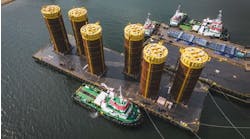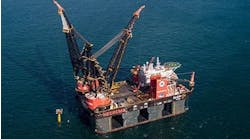Gene Kliewer, Technology Editor
The largest wide-azimuth seismic survey in the world is progressing well in the Walker Ridge area of the Gulf of Mexico, says CGGVeritas. The data library survey covers 464 lease blocks and includes the Jack discovery by Chevron.
This map indicates the location of the deepwater seismic survey extent in the Walker Ridge area of the Gulf of Mexico.
“Our first non-exclusive wide-azimuth survey brings a whole new scale of data acquisition to a highly prospective area of the Gulf of Mexico,” says Tim Wells, president, Western Hemisphere, CGGVeritas. “The survey is substantially pre-funded by multiple clients and will provide our customers with increased illumination and an enhanced understanding of the complex geology of the deepwater Gulf of Mexico.”
“The company began acquiring data in April and it is going along nicely,” says Andrew Phipps, vice president of Marine Data Library for CGGVeritas.
So far as data acquisition is concerned, there have been few challenges in the deepwater. The remoteness means there are few fixed structures to circumnavigate during the survey.
“The trick is going to be in the processing,” says Phipps.
Using proprietary software specifically designed for wide-azimuth geometry, including 3D SRME, tomography, beam migration, and wave equation migration, processing of the wide-azimuth data will begin two weeks after the first sail line has been recorded, and a Fast-Trax Migration will be ready approximately two months after completion of acquisition in early 2008.
Including two areas for development, the survey will last 12 months. 2Q 2008 is the scheduled end, with 2Q 2009 the delivery of the final product.
“We believe we have a lead in processing,” Phipps says. “We actually have a proven methodology to process the data. A number of modules were rewritten specifically for wide azimuth acquisition.
“What we are after is an image that gives understanding of what is below the salt. It all started with Mad Dog where there was a discovery without accurate seismic imaging.
“The thinking is this is food for the imagination. These are difficult prospects. The results can be used in an exploration mode to see something never seen before.”
The problem, and consequently the purpose behind the wide-azimuth data acquisition, is providing reliable information regarding the seabed beneath the salt formations. Dependable sub-salt imaging remains a development target for the industry.
“We’re using theViking with 10 streamers and four single-source vessels,” Phipps says. “This allows a 2,000-m (6,562-ft) wide swath in one pass. It is the most efficient way to get wide azimuth with one recording vessel. We are shooting southwest to northeast.”
The SR/VVeritas Viking is recording the wide-azimuth data along with four newly rigged vessels - the Sigma, Bjorkhaug, Tenor, and Vardholm - acting as source vessels. Together, they are using an acquisition configuration modified from the industry-first deepwater Gulf of Mexico survey Veritas recorded in 2006. The modified acquisition configuration is designed primarily for regional exploration purposes.
This configuration records double the cross-line offset with each sail line compared to previous wide-azimuth surveys, while maintaining data quality.
TheViking has solid streamers and group intervals can be either 12.5 m (41 ft) or 25 m (82 ft). Deployment and retrieval of towed equipment is controlled by a computerized towed-array management system, to minimize handling problems and associated downtime.




